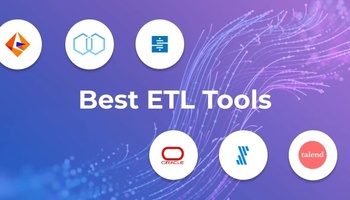Data comes in many sizes and formats, and it’s your job to process and handle this data in order to extract the valuable hidden insights it contains.
ETL is an established data integration procedure that efficiently moves information from source locations to targets so that you can use it for reporting and analytics. You may have already heard of ETL, but have you heard of its cousin ELT? As their names suggest, ELT and ETL are highly similar, but with several important distinctions that you need to know about to decide which one is right for your organization.
If you’ve ever wondered “What is ELT?”, this article is for you. Below, we’ll discuss everything you need to know about ELT and data integration, including the differences between ETL and ELT, the pros and cons of ELT, and the situations when you should use ELT.
What is ELT?
ETL (extract, transform, load) is an acronym for the three stages of the data integration process. ELT is a variation on ETL in which the data first enters the target database before undergoing transformations.
The three stages of ELT are:
- Extract: First, ELT extracts information from one or more data sources. This could be computer files, relational and non-relational databases, websites, SaaS (software as a service) platforms, and others.
- Load: Second, ELT loads the extracted data into a target location. This may be a data warehouse with a relational schema or a data lake that can hold very large quantities of unstructured information.
- Transform: Third, ELT transforms the loaded data in place. There are many types of data transformations, including data cleansing (deleting out-of-date, inaccurate, and/or duplicate records); data joins (combining data from two or more different sources); summarizing (creating new data records based on existing ones); validating (writing automated checks on data quality), and many more.
ELT is possible thanks in large part to recent developments in cloud computing, which have dramatically increased the storage space and compute power available to end-users. The ELT process is a more modern alternative to ETL that takes advantage of new technological capabilities; however, it is still evolving in many respects.
The Differences Between ETL and ELT
The biggest and most obvious differences between ETL and ELT are the order of the three stages and the final destination of the data. However, these differences also have significant consequences for the use of ETL and ELT in practice. Below are some noteworthy implications of the ETL-ELT differences:
- ETL processes often use a staging area between the transformation and loading phases. This is an intermediate location where data is temporarily stored and often manipulated before entering the data warehouse. By contrast, ELT processes do not require a staging area, since all transformations occur in-place at the target location.
- ELT is relatively low-maintenance when compared with ETL. With ETL, we need to select our data sources and transformations carefully. With ELT, on the other hand, we can afford to be less selective about the data we load into the target location, since the transformations will occur at a later time.
- Regulations such as GDPR and HIPAA may require you to redact and/or encrypt sensitive and confidential information before uploading it to the cloud (e.g. a data warehouse or data lake). However, by default ELT does not perform any transformations on the raw data before loading it. ELT users thus need to be careful to ensure that they comply with all applicable laws and regulations.
The Pros and Cons of ELT
The advantages of ETL include:
- More flexible: Because ELT does not transform data before loading it into the target location, the ELT process is capable of working with a wider variety of data formats, including unstructured data.
- More dynamic: ELT enables a more fluid and dynamic approach to data integration. Instead of transforming the data immediately, users can perform new transformations on the raw data inside the data warehouse or data lake.
The disadvantages of ELT include:
- Less reliable: ELT is a newer approach to data integration than ETL, which means that many ELT tools and systems are less mature than their ETL counterparts.
- Harder to find talent: Another consequence of ELT being newer is that it’s harder to recruit for ELT talent. If you want to build your own ELT pipeline, it will be more difficult to find skilled ELT developers than it would be for the ETL equivalent.
When to Use ELT
The question of ETL vs. ELT is one that will heavily depend on your unique situation.
For one, using ELT is the clear-cut choice if you want to use a data lake instead of a data warehouse. Only ELT, and not ETL, is suitable for migrating information into a data lake. ETL performs data transformations before loading the data into a target location, which means that you lose all of the advantages of using a data lake in the first place.
The reasons to use a data lake include:
- A large portion of the data has an unstructured or semi-structured format, and you don’t want to convert it to structured data before using it.
- Data is arriving too quickly to plan for the necessary transformations.
- The structure of the analytical queries isn’t known in advance.
In particular, ELT is best suited for target systems that are powerful enough to handle in-place data transformations: for example, enterprise cloud databases such as Amazon Redshift and Google BigQuery.
When to Use ETL
ETL is the best choice for traditional data integration workflows. This generally means that your data sources are fairly constant, you know the format of your queries, and your data fits neatly into a relational database schema. ETL tools can leverage the inherent structure of ETL to improve the performance and predictability of the data integration process.
The good news is that the choice of ETL vs. ELT doesn’t have to be an either/or proposition—you can use both of them in combination as best matches your needs. This is especially true if you select an ELT tool that supports both ELT and ETL, such as Integrate.io.
Why Choose Integrate.io for ELT?
Integrate.io is a powerful, feature-rich data integration platform designed to streamline and simplify the ETL and ELT processes. With more than 100 pre-built integrations and a user-friendly drag-and-drop interface, Integrate.io lets even non-technical users start building data pipelines between sources and target data warehouses and data lakes. Because Integrate.io supports both ETL and ELT, you can easily use either or both of these architectures for your enterprise data integrations.
Interested in trying Integrate.io’s ELT capabilities out for yourself? Get in touch with our team today for a chat about your business needs and objectives, as well as a free trial of the Integrate.io platform.













